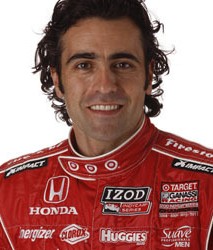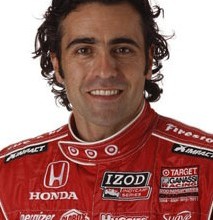Ask a pro
Receive advice directly from today’s top stars


Dario Franchitti
Four-time IndyCar Champion
Since switching his sights from Formula One to a career in the United States in 1999, Dario Franchitti has risen to become one of the world’s most successful – and recognizable – race car drivers. The native of Edinburgh, Scotland, earned his fourth IZOD IndyCar Series Championship in 2011, tying him with Mario Andretti and Sebastien Bourdais for second in the record books. Only A.J. Foyt, with seven titles, has won more. His current tally of 30 race wins places him ninth on the all-time list. Franchitti matched his idol, Jim Clark, by winning the Indianapolis 500 in 2007, and repeated the feat in 2010. For 2012, Franchitti will continue to drive the #10 Dallara-Honda DW-12 for Target Chip Ganassi Racing.
www.Franchitti.com
Dario Franchitti answers your questions!
-
Vaggelees Zachos
When entering a corner, do you actually look at the apex and then turn the wheel or do you have a picture in your mind of where you want to end up in the corner beforehand, and then you steer?




I look at the apex. If you ever look at a picture of me driving, from the time I’m braking, my head is tilted over and I’m looking at the apex – sometimes from even before I’ve touched brakes – and everything before the apex is about getting to the apex.
-
Tony Machi
When you were growing up, did you ever dream about being anything other than a professional race car driver? Did you ever pursue any other career path?




Not at all, no, I didn’t. I remember being 3 years old and wanting to do this. This is all it’s ever been and I’ve been lucky enough to find myself here in this position.
-
Darren Jack
A few years ago, someone said to me that Gil de Ferran was the best driver that never raced in Formula One. I didn’t disagree but said that I would include A.J. Foyt and Tom Kristensen on that list. After watching your impressive success over the past few years, I would say your name should be on that list. Who would be on your list?




I think you’ve mentioned some great names there. Obviously, I think number one on that list would be A.J., but I would also include guys like Parnelli Jones and Rick Mears. I remember Rick drove a Brabham in a test at Riverside but he never raced in F1. You know, there are so many. A lot of people say, well, if you haven’t raced in Formula One then you can’t be all that good, but I kind of see things a little bit differently.
-
Anonymous
Do the pedal and foot well arrangements in the new Indy car discriminate against right-foot braking?




Yes, they absolutely do. Even the kit they’ve come out with is a bit of a botch-job, because they haven’t positioned the pedals anything like where they should go; it’s as close as they could get. In order for the car to be equally comfortable for left- and right-foot brakers, you’d have to modify the front bulkhead and they’re not prepared to do that.
-
Paul H
I am 30 years old and have been karting on and off for the past 10 years. Is it too late for me to make it to the next level? Is it worth taking out a loan to buy a professional ride in an attempt to be hired in the future?




I’m never going to tell anyone they can’t do something. I just think it’s wrong to say no, you shouldn’t, but I will say that there’s a lot of things stacked against you at this point.
-
Gil de Ferran
What is up with the oversize sideburns?




Actually, I need a haircut right now but that whole thing started as a tribute to Jackie Stewart and those guys in the early ‘70s – he and Emerson Fittipaldi and those guys who had massive sideburns – so I grew them and Jackie said they were worth half a second a lap! Gil’s just jealous because when he grows them they come out grey.
-
Nick Martin
I am currently in karting. What should be my next step to becoming an INDYCAR driver?




Whatever you do, it’s important to be successful, to be winning. It’s so difficult to say what should be the next step because there’s so many different options, depending on where you’re racing, but in North America I think the Mazda Road to Indy ladder system is probably the next step. You can go to USF2000, or you can start in Formula Ford – or FF or F1600 as it’s known these days; it depends on the size of your budget.
-
Roberto Vilarinho
When asked by your engineer to save fuel in order to finish a race stint, how do you modify your gearshift/braking/acceleration in order to accomplish this? Or is it done entirely by engine mapping/fuel mixture settings on your steering wheel?




That’s a secret. I’d like to keep that one to myself, if you don’t mind. There’s definitely some ways to do it. Probably the only thing I can say is just experiment with it and you will see the benefits. There’s definitely a black art to it and you can definitely, as a driver in the car, do a lot. Also the manufacturer can do things with the fuel mixture, for example, but obviously the more fuel you take out the slower it goes, so there’s a balancing act, and especially with the way our INDYCAR races are structured with the fuel tank size and all that stuff, it’s a big part of our sport.
-
Susan
I wanted to ask you about Long Beach – what goes through your head when the car just isn’t getting up to speed, especially after sitting on the pole?




At times at Long Beach it was an embarrassment. It was just a horrible race from start to finish. I was on a two-stop strategy so from the first corner we were trying to save fuel. It probably looked worse than it actually was in those opening laps because I was already trying to save fuel, but it just wasn’t working and the balance of the car went away, then I damaged my car’s nose…. Some of that was just getting used to these cars – how long the nose is on the car. Ryan Briscoe came across the front of me and I braked to avoid making contact but the nose is another foot longer, or something, than the old car, so the contact was made. There was a lot of frustration but at the same point you can’t let your feelings take over; you have to keep focused and try and improve it. You don’t just get fed up; you talk to the pits. Can you improve it? What do you need? How can you make this work? So that was a character-building day.
-
Joey Selmants
What is your strategy for rolling starts? Do you have one foot on the brake and one on the gas and does your strategy change depending on your grid slot?




It can change depending on your grid position, absolutely. You can have one foot on the brake, one foot on the throttle, depending if you’re trying to build the (turbo) boost. There is some complexity to that. At Long Beach we had what is called an “over-boost penalty” – when the engine asked for too much boost – and we had that on one of the restarts. It went off four times, and each time it effectively cut the engine off. There was one restart, I think I restarted second and ended up about eighth going into the first corner, and that’s just because the thing cut out four times – and it cut out for a second or so each time. So there are definitely different techniques for restarts and a lot of it will depend on your circumstances. You’re obviously trying to anticipate what’s going on if you’re not on the front row, or if you’re at the back as well, and sometimes you’re just trying to get formed up before they throw the green, so it really depends where you are in the formation.
-
Mike Milners
If you are driving subconsciously, almost like on autopilot, what do you think about to stay in the zone mentally?




When you’re in that subconscious state, that’s the best. You’re just in the rhythm, in the zone. You don’t need to work at anything, you’ve got yourself in that zone and, look out, that’s when you’re doing your best work. It’s those days when you’re not in that zone that you’ve got to get into it. It’s what Jackie Stewart called mind management. You’ve got to learn how your mind works and you’ve got to figure out what works for you to get you in that zone. For me, when I’m in that zone, strange things pop into my head – the strangest things. I remember in Japan once it was a comedy sketch that I’d heard the night before. It was Billy Connelly, and it came into my head every time at the same point in the lap, 200 laps in a row! Crazy stuff like that.
-
RJ Duffey
Did you ever try left-foot braking?




You know, I left-foot brake in the Grand-Am car at Daytona because the guys don’t like me using the clutch to get it down through the ‘box for reliability. So I left-foot brake in that car, and unfortunately, most of the testing I did in the Indy car over the winter was left-foot braking, and that put us behind a little bit, to be honest, because INDYCAR and Dallara were very slow to see the need for a right-foot braking kit. So I can do either but I’m definitely more comfortable – and faster – when I’m braking with my right foot.
-
David Sims Jr.
I’m an 11-year-old go-karter and I’m having difficulty finding sponsors due to the lack of having something to offer them in return for their financial support. What can I do to help persuade someone to invest in me at this point in my career?




Jackie Stewart always taught me that regardless of what stage you’re at, you should think about what you can offer the sponsor in terms of value. It may not be exposure or any of the traditional things, but it might be the emotional value of getting involved. I think that’s the key. Funnily enough, in my current memorabilia area, I have a letter my grandmother wrote to Jackie when I was racing go-karts, asking that very same question, and that was the advice he gave. If you have the opportunity and you have a friend who you think can help, or friends of friends, go to people you know. Don’t just go to anonymous companies; go to people that you or somebody around you has a connection with.
-
Jonathan Sugianto
You have become known for your composure before a race. Do you have any tips on how to prepare before the start of a race?




Yes. Be focused. Don’t be distracted. Don’t be looking around and seeing what’s going on or who’s there. Just focus on what’s going on inside your head, rather than what’s going on outside. You can do some deep breathing, relax yourself and bring your heart rate down. Just compose yourself and think about all those different things that you’re going to have to do during the race. Some people need themselves pumped up; some people need to relax. I prefer to chill out beforehand and get ready that way.
-
Andres
Do you think that simulators are a good way of improving your driving skills?




Yes and no. I think, for me, simulators are a great way of getting the buzz of racing and the entertainment as well, and the enjoyment of driving. The one thing a simulator doesn’t really convey is the G-forces on your body and the feeling of the car. Regardless of how good the movement is on the simulator, a good percentage of the feelings you get from a car is what’s happening with your butt. When you’re feeling the sliding or the grip levels, it’s a combination of visual and your balance and the feeling you get from your butt. With the simulator, it’s all hand-eye. It’s a tough thing to replicate but they can be very useful, yes.
-
Marc Cohn
What is the single best experience you have ever had in a race car?




Winning Indy, that is something that’s very, very tough to beat, but for me, there are those days when you’re out in the car on a great track and you absolutely just nail a lap. You get it. You just think wow, I drove a great lap. The car is feeling exactly as you want it and nobody else will know about it. The engineers might know because they looked at the data and saw it was pretty good but it’s a very personal thing because it’s just you and the car. Nobody talks about it on TV or whatever and it’s just pure enjoyment. Those moments are really tough to beat. I remember one day at Mid-Ohio, I think it was ‘98 or ‘99, battering on around there and I just thought, this is brilliant, this is what it’s about! I remember the same – actually, funnily enough at Mid-Ohio again, Scott Dixon and I were racing and I was having the time of my life. It was brilliant. It’s very seldom you think that in the car because you’re so focused and your brain is processing so much information, you don’t have time to think those things, but when you actually get that chance it’s pretty cool.
-
Eric Shaun
Do you have any words of wisdom for Josef Newgarden?




No. His move at Long Beach, I think, was very aggressive but I think we were both at fault at different times in that first corner. And I think the way that Josef handled it, to me, further impressed me. We spoke the next morning and I said to him, ‘Josef, I don’t think we touched but if I touched you, I apologize.’ Really, that’s not what I wanted to happen. We had this conversation but the way he handled it, first of all on television and secondly with me, I just thought he’s the real deal. Obviously, we’ve seen what he’s done in the car so far this season but just the way he handled that situation impressed me, so I don’t think Josef needs any advice. He’s done a very impressive job and I think will continue to do so.
-
Cecilia
Training your body is part of keeping fit for the races, but how do you train the brain to keep focused throughout the race?




I think a lot of that is built up from years of experience. That’s a great question. You start off with shorter races and you learn to concentrate for that length of time, and then as you move up the ladder and the races are a bit longer, the cars a little bit faster, you learn to concentrate for that whole time, and that goes on. For me, though, the first thing that happened when I drove the next level of car above – whether it was going from Vauxhall Junior to Formula Vauxhall-Lotus or the Formula 3 car or the DTM car or the Formula 1 car or the first time I drove a Champ Car, my brain was just trying to process the speed at which things came at me. It was like somebody took a DVD and fast-forwarded it and you were trying to process that information. That was the first thing to master, and then the focus over the race distance came along and then it was the ability to think about other things while you’re driving at that speed, that was the next thing.
-
Scott Madans
It can be said that business agreements have “teeth” – or performance guarantees. Probably different at all levels, but what types of guarantees are sponsors looking for? What’s realistic? Besides sponsor event appearances, how do race teams deliver on their value proposition?




Well, I think there’s two things. Obviously, for the sponsor, value can be performance-based – it can be measured in terms of coverage that you generate, whether it’s on TV or in column inches – or they can use it to entertain their customers, their partners or prospective customers. So there’s all different kinds of things. I don’t think I’ve ever been involved with any sponsor who either myself or the team has given guaranteed performance, because you’re just setting yourself up to fail.
-
Mike Milner
When passing into a corner under braking, what is the visual trigger or decision point that tells you there is room to continue without making contact?




I think it comes from experience really. It’s a combination of speed differential, distance, point on the track, what’s the next corner like, the position you’re able to get into… a lot of different things. I think one thing I’ve learned is don’t second-guess yourself. If you decide to go for it, go for it. It’s when you go for it and back off and then go for it again that you get in trouble. Be assertive, I would say.
-
Chris Keller
What do you consider to be your home track? Can you describe it?




I always consider my home tracks to be the ones in Scotland, whether it’s Knockhill or Larkhall, which is a go-kart track where I had my very first race. Knockhill is a bit like Sonoma, with a lot of elevation change and a lot of blind corners. It’s a bit shorter but it’s a real challenge. My dad raced there before me and it’s a track that has a lot of history, whether it was Allan McNish, David Coulthard, myself, my brother Marino, Paul Di Resta, we’ve all raced there. Larkhall is where I first started racing and it’s a great track with a lot of different types of corners from really fast sweepers to a couple of hairpins. I learned my craft there.
-
Jack Mitchell
At what point in your career did you know you had what it takes to be a pro?




That’s a tough one because I’ve always looked at things like that from a very pessimistic standpoint. A lot of people are full of confidence and think they’re the best in the world and nobody’s better. I’ve always thought of it from the other way. I think when I won my first championship in Formula Vauxhall Junior, driving for David Leslie (1991)… but it was really when I drove for Jackie Stewart at Paul Stewart Racing that things ratcheted up a level, and then when I got my first paycheck from Mercedes I maybe realized I could do this for a living. But I always felt, and I kind of still feel, that somebody’s going to come and take it away.
-
Kiel Hogan
What do you do to stay in shape? What is the most beneficial thing a driver can do physically to prepare for racing – other than racing itself?




It’s an ongoing – I describe it as a battle, and one that definitely gets more difficult as you get older, but my weeks are very planned out with different types of training. Whether it’s running, cycling, rowing or different types of things for cardio, whether it’s long-distance stuff, more sprint-oriented as well, it just depends on what we’re trying to achieve. There’s definitely a big combination of cardio stuff and doing some weights to try and simulate what we go through in a car, and I tend to spend a lot of time on it every week. I’m not one of those guys that will Tweet every time I go out for a run – I like to keep what I do very much to myself – but definitely in any week I spend far more time training than anything else. Apart from sleeping maybe.
-
Richard Fan
Dario, who is the better racing driver, you or Jim Clark? Seriously, do you think you could have had a very successful racing career back in those dangerous years?




I don’t know. I would like to think so but for me I think Jim Clark is on a different level. I think I’ve done OK and I’m very proud of my achievements but for me, Jim Clark was and is recognized as one of the greatest ever, so I don’t think there’s any comparison there.
-
James Chapman
If someone has very little money, what is the best way to begin to make a career in racing?




Anybody that’s had any exposure to racing will realize that it takes a great deal of money to go racing – to be a driver, to be a team owner. There are all sorts of options if you want to be involved in racing, whether that’s as a mechanic, as an administrator, on the PR side; whether it’s working with the INDYCAR series or any other series or a manufacturer, but I think if you want to be a driver, it comes down to money. If you don’t have that, then if you can get support from other people, that’s the way to make it happen, but it’s very difficult. I was incredibly lucky. Through my karting years and the first year of my car racing career, my parents put everything they had into my racing, and I was very lucky to have understanding team owners, with David Leslie Jr. and Sr., who realized we couldn’t pay all this money. And then Jackie Stewart came along and that was the next stage. Without my parents, David Leslie and Jackie saying, ‘I’ll find the sponsors; you drive the car’ – without those things happening, it would have been very difficult. With Jackie, I ended up doing a future-earnings deal. He found the sponsors – he paid some of it, I believe, out of his own pocket – and when I made some money, I was able to pay him back. I remember being 16 years old and thinking, ‘How the hell is this going to happen? I just do not see a way.’ The big thing that allowed me to do it was my dad re-mortgaging the house and then telling my mom afterward! I’ve been in that position and it’s a very tough position to be in, and there’s no easy answer to it.
-
Hawley T. Chester III
With limited time, what is the quickest and easiest way to learn a new track?




For me, walking it. I guess the way I tend to do it is I look at a track map, then I walk it and then drive the car. There are some great simulators now that some teams use – things like Simraceway that I’ve become involved with; they have a great simulator which you can use to learn a track – but I think walking it is the best thing for me.
 Road Racing Drivers Club
Road Racing Drivers Club
 Share
Share







